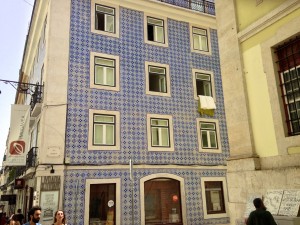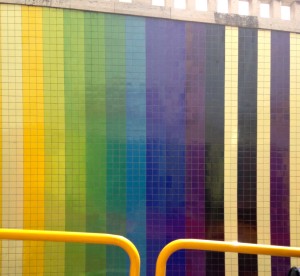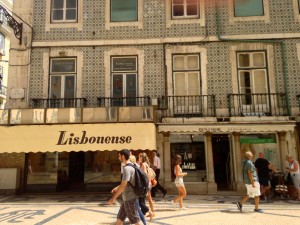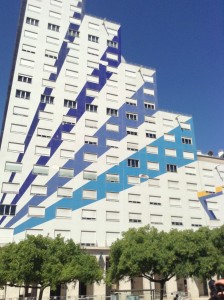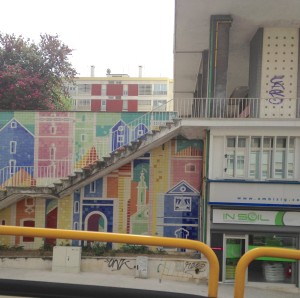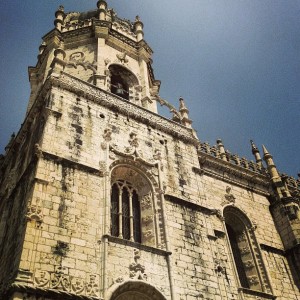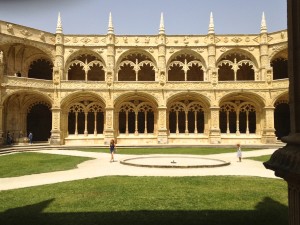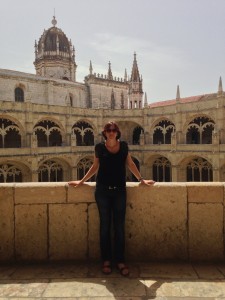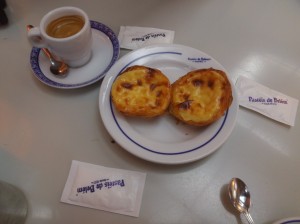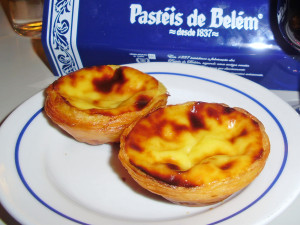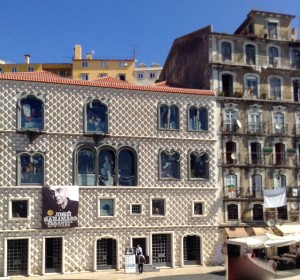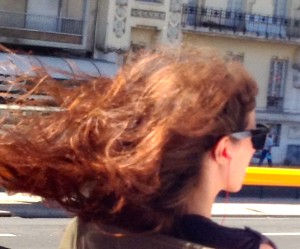Sant Iago
There are many pilgrim paths to Santiago. One of them is the Camino Portuguese, starting in Lisbon, Portugal. The Portuguese way is significantly connected to St James. It was along this route St James preached Christianity to the pagans and along this way, his body made its last journey.
St James (or Sant Iago in Spanish) was one of the original twelve apostles, who followed Jesus and helped to establish the Christian faith. After the crucifixion and resurrection of Jesus, James travelled across the Mediterranean to Spain to preach. Around 44 AD he returned to Jerusalem and was beheaded by Herod Agrippa. Legend goes that to prevent its desecration, believers secretly carried his body back to Spain and buried it near the northern coast. There it lay undisturbed for nearly 800 years until 813 A.D. Within 100 years, people from all over the European continent were making the harrowing, frequently life-threatening journey to the grave site. A church was soon built over his bones, and around it arisen the town of Santiago de Compostela.
Lisbon
We considered walking the Camino de Santiago from Lisbon (615 km) but decided that we would rather walk the more traditional Camino Frances. We decided to enter Europe via Lisbon, because we wanted to see a bit of Portugal. We were pleasantly surprised with the city of Lisbon. It is one of the smallest capital cities in Europe. It is a friendly city with vigour and a fascinating history. Great explorers such as Columbus, Magellan and Vasco da Gama set sail from Lisbon. In 1755 one of the most destructive earthquakes and ensuing tsunami destroyed 90% of the city and killed a quarter of its population.
We arrived at our hostel in the suburb of Restauradores, the entrance through a little shop. We booked in but because we were too early, we could not occupy our room. Our luggage was stored and we decided to explore our surroundings. A bit tired after the more than twelve-hour flight, it disappeared when we hit the road and pulled into the vibe of the city.
City of Tiles
Lisbon is an amazing city. It is lively city full of very interesting, vibrant people. The architecture of Lisbon varies from old buildings to modern, but mostly old.
There are beautiful old buildings, some well maintained, many with tiled walls. Portuguese tiles, known as azulejos decorate the inside and outside of almost every home in Portugal.
New tiled buildings were in contrast with existing old buildings.
Mosteiro dos Jeronimos
The monastery was commissioned in 1501 by Manual I after Vasco da Gama’s return from his historic voyage. This is one of the buildings that survived the 1755 earthquake.
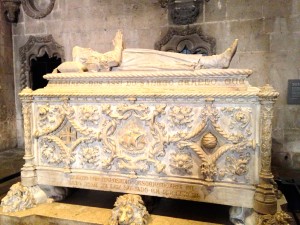 Tomb of Vasco da Gama (1469 – 1524). He was a Portuguese explorer, the first to sail directly from Europe to India. Da Gama’s voyage was successful in establishing a sea route from Europe to India that would permit trade with the Far East, without the use of the costly and unsafe Silk Road caravan routes of the Middle East and Central Asia.
Tomb of Vasco da Gama (1469 – 1524). He was a Portuguese explorer, the first to sail directly from Europe to India. Da Gama’s voyage was successful in establishing a sea route from Europe to India that would permit trade with the Far East, without the use of the costly and unsafe Silk Road caravan routes of the Middle East and Central Asia.
Pastries
A pastel de nata is a Portuguese egg tart pastry, common in Portugal. It is believed that pastéis de nata were created before the 18th century by Catholic monks at the Jeronimos Monastery. During Portuguese medieval history, the convents and monasteries of Portugal produced large quantities of eggs, whose eggwhites were in demand for starching of clothes and in wineries. It was quite common for these Portuguese monasteries and convents to produce many confections with the leftover egg yolks, resulting in a proliferation of sweet pastry recipes throughout the country.
Following the closing of many of the convents and monasteries in the aftermath of the Liberal Revolution of 1820, the production of pastéis de nata passed to the Casa Pastéis de Belém nearby. The former religious clerics, in order to keep producing the secret and distinct recipe, therefore patented and registered the confection, while contracting the Antiga Confeiteira de Belém to produce pastries based on their original recipe. The secret was transmitted to five master pastry chefs who guarded this original recipe, under the Oficina do Segredo, which later passed into the hands of familial descendants.
Since 1837, locals and visitors to Lisbon have visited the bakery to purchase fresh from the oven pastéis, sprinkled with cinnamon and powdered sugar. Their popularity normally results in long lines at the take-away counters, in addition to waiting lines for sit-down service. We went to this venue several times to taste the heavenly pastel de natas.
Sightseeing
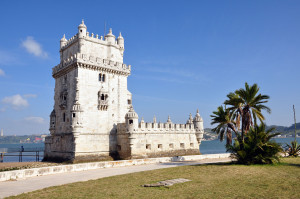
Torre de Belém, is a fortified tower located in Santa Maria de Belém in Lisbon. It is a UNESCO World Heritage Site (along with the nearby Jerónimos Monastery) because of the significant role it played in the Portuguese maritime discoveries of the era of the Age of Discoveries. The tower is at the mouth of the Tagus River and a ceremonial gateway to Lisbon.
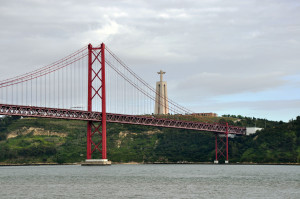
Built in 1959 in gratitude to God for having spared Portugal during WWII, this enormous monument to Christ was inspired by the famous statue in Rio de Janeiro. During World War II, Portugal remained neutral for several reasons, contributing to the rescue of a large number of refugees and preventing war casualties for the Portuguese.
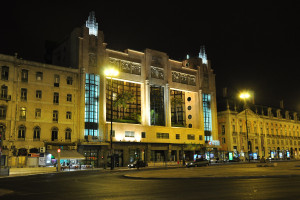
This was one of Lisbon’s major cinema/theatre buildings and its imposing facade still dominates the main city square Praca dos Restauradores. It opened in 1931. Sadly, this magnificent cinema closed in 1989 and lay unused for many years. It was used as a location in the Wim Wenders movie “Until the End of the World” (1991). In 2001, it was converted into a 134-room apartment hotel known as the Orion Eden Hotel.
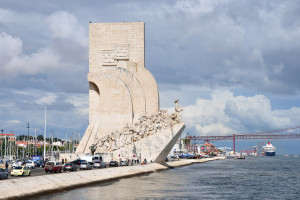
The 52 meters monument, shaped like a ship’s prow, stands at the marina in Belém, the starting point for many of Portugal’s explorers. This is where in 1497 Vasco da Gama embarked on his voyage to India. The monument shows more than 30 statues of people who played an important role in the discoveries.
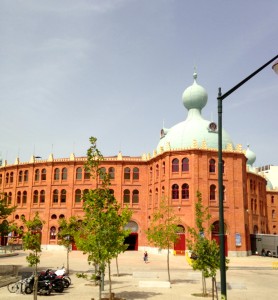
Bullfights are held in Campo Pequena. There are significant differences between the Portuguese and the Spanish bullfighting, in Portugal bulls are not killed at the end of the show (a royal decree given by King Miguel of Portugal). Bullfights are held several months a year, whereas for the rest of the year the bullring is used for concerts, exhibitions, etc.
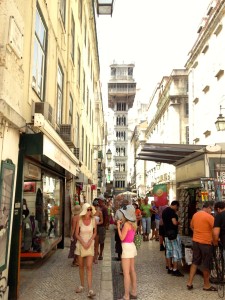
Users of the lift of de Santa Justa can travel up and down inside the tower in one of two smart wood-panelled cabins with brass fittings. At the top of the elevator is a walkway linking it to the Largo do Carmo in the Bairro Alto 32 m above.
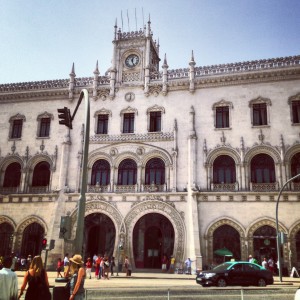
Looking more like a theatre or a palace with horseshoe arched doorways, this building located between Rossio and Restauradores squares was built at a time when train stations were seen as temples of technology. It is one of the strangest architectural complexes housing a rail terminal in Europe, and today it is the local station for trains to Sintra.
Casa dos Bicos is a 16th century palace that is one of the very few buildings that survived the 1755 earthquake. Its interior is occupied by the Saramago Foundation, a space dedicated to the Nobel Prize-winning Portuguese writer José de Sousa Saramago, (1922 – 2010). It hosts special literary events and contains the author’s library.
While on the sightseeing bus, this girl with the most beautiful hair sat in front of us.
We arrived in Lisbon on Wednesday 21 August 2013 and departed with the night train to Irun on Friday evening 23 August 2013 where we planned to start walking the Camino. On Friday morning we had to book out from our accommodation and hit the road with our backpacks to visit and revisit some of the places in Lisbon.
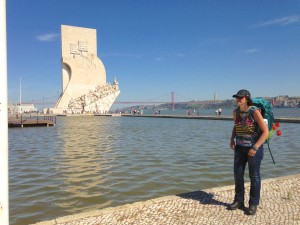 While walking the streets of Lisbon with our backpacks we realised that the backpacks were too heavy. The temperature in Lisbon was in the range of 30 degrees C, and we were walking in the heat of the day. We repacked our backpacks and arranged to store the things that we considered not essential, to be picked up when we came back to Lisbon at the end of our Camino walk.
While walking the streets of Lisbon with our backpacks we realised that the backpacks were too heavy. The temperature in Lisbon was in the range of 30 degrees C, and we were walking in the heat of the day. We repacked our backpacks and arranged to store the things that we considered not essential, to be picked up when we came back to Lisbon at the end of our Camino walk.
